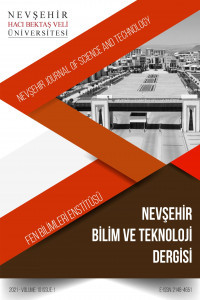Yüksek Sıcaklığa Maruz Uçucu Kül İçeren Betonun Ultrases Geçiş Hızı ve Basınç Dayanımının Değerlendirilmesi
Yüksek sıcaklık, uçucu kül, ultrases geçiş hızı, basınç dayanımı
Ultrasonic Pulse Velocity and Compressive Strength Evaluation of Concrete Containing Fly Ash Exposed to High Temperatures
High temperature, fly ash, ultrasonic pulse velocity, compressive strength,
___
- [1] Neville, A.M., “Properties of Concrete” John Wiley&Sons, New York, 1997
- [2] Hertz K.D., “Concrete strength for fire safety design” Mag. Concr. Res., 57, 445–453, 2005
- [3] Khoury G.A., Majorana C.E., Pesavento F., Schrefler B.A., “Modelling of heated concrete”, Mag. Concr. Res., 54, 77–101, 2002.
- [4] Georgali B., Tsakiridis P.E., “Microstructure of fire-damaged concrete”, Cem. Concr. Comp., 27, 255–259, 2005
- [5] Demirel B., Kelestemur O., “Effect of elevated temperature on the mechanical properties of concrete produced with finely ground pumice and silica füme” Fire Safety J., 45, 385–391, 2010
- [6] Arioz O., “Effects of elevated temperatures on properties of concrete” Fire Safety J., 42, 516–522, 2007
- [7] Baradan B., Yazıcı H., Ün H., “Beton ve betonarme yapılarda kalıcılık (durabilite)”, İstanbul 2010
- [8] Feldman R.F., Ramachandran V.S., “Differentiation of interlayer and adsorbed water in hydrated portland cement on thermal analysis” Cem. Concr. Res. 1, 607–620, 1971
- [9] Khoury G.A., Majorana C.E, Pesavento F, Schrefler B.A., “Modelling of heated concrete” Mag. Concr. Res., 54, 77–101, 2002
- [10] Zega C.J., Di Maio A.A., “Recycled concrete exposed to high temperatures” Mag. Concr. Res., 58, 675–682, 2006
- [11] Yuzer N., F. Akoz F., Öztürk L.D., “Compressive strength–color change relation in mortars at high temperature” Cem. Concr. Res., 34, 1803–1807, 2004
- [12] Georgali B., Tsakiridis P.E., “Microstructure of fire-damaged concrete” Cem. Concr. Comp., 27, 255–259, 2005
- [13] Vydra V., Vodak F., Kapickova O., Hoskova S., “Effect of temperature on porosity of concrete for nuclear-safety structures” Cem. Concr. Res. 31, 1023–1026, 2001
- [14] Masse S., Vetter G., Boch P., Haehnel C., “Elastic modulus changes in cementious materials submitted to thermal treatments up to 1000 oC” Adv. Cem. Res. 14, 169–177, 2002
- [15] Ergün A., Kürklü G., Başpınar M.S., Mansour M.Y., “The effect of cement dosage on mechanical properties of concrete exposed to high temperatures” Fire Safety J. 55, 160-167, 2013
- [16] IS 13311 Part I Standard code of practice for non-destructive testing of concrete: part 1-ultrasonic pulse velocity bureau of indian standards, New Delhi, 1992
- [17] TS EN 12390-3 Testing hardened concrete-part 3: compressive strength of test specimens, Ankara, 2010
- [18] Rao S.K., Sravana P., Rao T.C., “Experimental studies in ultrasonic pulse velocity of roller compacted concrete pavement containing fly ash and m-sand”, Pav. Res. And Tech. 9, 289–301, 2016
- ISSN: 2148-466X
- Yayın Aralığı: Yılda 2 Sayı
- Başlangıç: 2012
- Yayıncı: Nevşehir Hacı Bektaş Veli Üniversitesi
Muhammed Azim EIRGASH, Vedat TOĞAN, Aynur KAZAZ
Çevresel Su Örneklerinde GC/MSD ile Pestisit Analizi ve Metot Validasyonu
MOF-5 Bağlı Karışık Matriksli Membranların Sentezi, Karakterizasyonu ve Gaz Ayırma Özellikleri
Hülya AYKAÇ ÖZEN, Bahtiyar ÖZTÜRK, Hamdi ÖBEKCAN
Polietilen ve Kereste Tozlarının Ko-pirolizi: Piroliz Ürün Değeri Üzerinde Polietilenin Etkisi
Sinem UĞUZ, Tolga AYERİ, Yüksel ARDALI
Hasan Hüseyin DERTLİ, Fezayil SUNCA, Mehmet AKKÖSE
Şakir ERDOĞDU, Ufuk KANDİL, Memduh NAS, Şirin KURBETCİ, Safa NAYIR
Kızılırmak Havzasının Hidrometeorolojik Verilerinin Trend Analizi
Burcu ERCAN, Mehmet İshak YÜCE
Eskişehir’de Yer Alan Bazı Sulama Göletlerinin Su Kalitesinin Değerlendirilmesi
Arzu ÇİÇEK, Erhan UYSAL, Esengül KÖSE, Cem TOKATLI
Tekstil Endüstrisi Atıksularının Arıtımında Kullanılan Proseslerin Araştırılması
Bazalt Fiberle Güçlendirilmiş Doygun Silt Zeminin Mekanik Davranışının Deneysel İncelemesi
